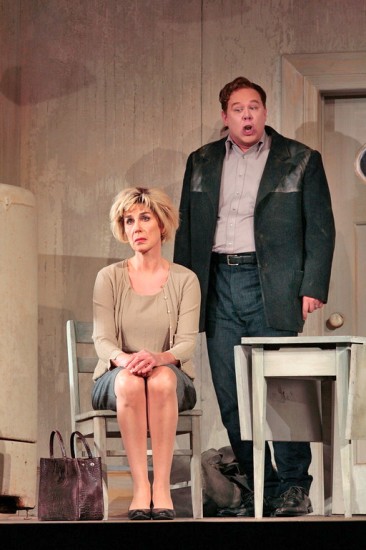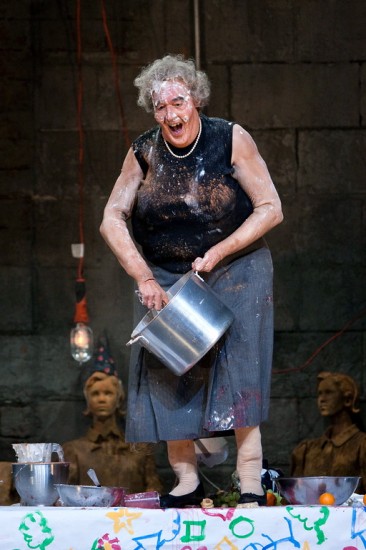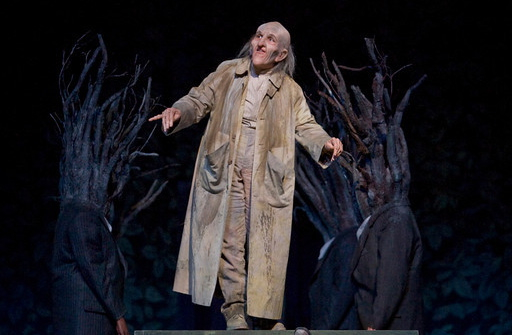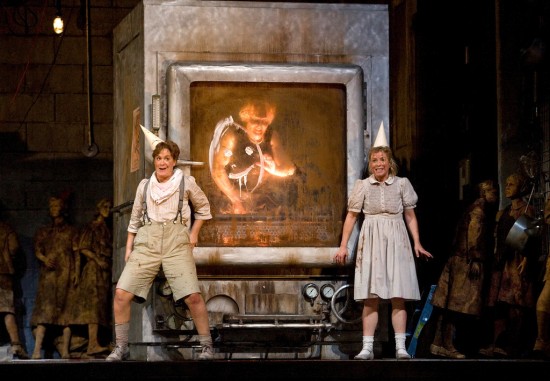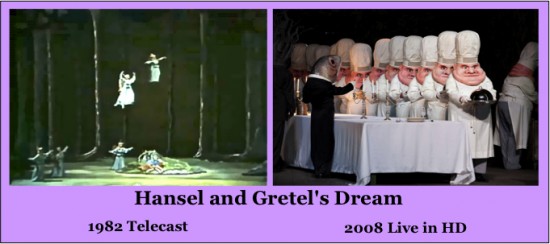Hansel & Gretel Preview – DÉjé vu all over again
It was a momentous year. Herbert Hoover was president – the “planet” Pluto was discovered – the Great Depression was settling in – the Empire State Building was rising up in New York – the Philadelphia Athletics were in the World Series. And the Opera Nut sang in his first opera.
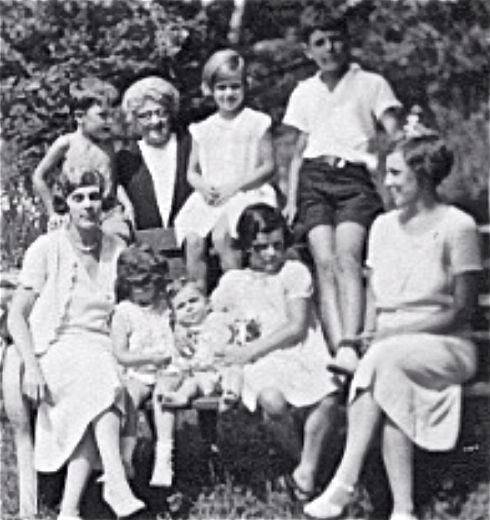
The Opera Nut (upper R) age 10 with siblings, cousins, mother (extreme R), aunt, and grandmother; family photo
Yes, as a member of Miss Eccles 4th grade class in Garden City, Long Island I was one of the children in a production of Engelbert Humperdinck’s Hansel and Gretel. I remember absolutely nothing about the performance, but I do remember many of the melodies and many of the (English) words to the songs. In fact, at the Met HD Encore at CinÉArts at Palo Alto Square last night, December 22, 2011, I had to consciously refrain from treating it as a sing-along. And whereas Maestro Vladimir Jurowski had all the music correct, I kept wanting to correct the translation of David Pountney since the words were different from the ones I learned long ago.

School children as Angels in Hansel and Gretel; Photograph courtesy of P.S. 99 (Paulette Foglio, Principal and Dan Morgan, Document Custodian)
I was not the only ex-child performer in the Palo Alto audience. Sara had her turn at an even younger age when she was in Miss Sourter’s 3rd grade class in Grand Rapids, Michigan. And she had a more important role, being one of the 14 angels in the famous dream sequence. We may not remember what we had for breakfast, but, by golly, we Elders remember clearly what happened more than half a century ago. Sara was one of the first pair of angels: “Two stand here above me.” Her robe was a white bed sheet, and her halo was an embroidery hoop. Mine was a colorful outfit which looked vaguely Dutch – handmade by my mother.
I was a voracious reader as a child, so I was familiar with most of the Grimm Brothers’ Fairy Tales, Hansel and Gretel in particular. However, I wanted to be sure of my facts, so I looked up Hansel and Gretel on the web and reread it, in English. The five main characters are all the same: Two children Hansel and Gretel, their parents Peter and Gertrud, and the wicked witch. And the basic story is the same.
Here is a brief synopsis that could apply equally well to the fairy tale by the Brothers Grimm and to libretto of the opera by Humperdinck’s sister Adelheid Wette:
Peter is a poor woodcutter who lives with his family in a hut in a clearing of a great forest. The family is very poor and seldom have enough to eat. The two children get lost in the forest and spend the night there. In the morning they see a magic house entirely made of sweets, and they start to eat pieces of it. A witch comes out of the house and encourages the children until they are firmly in her power. Then she imprisons Hansel and turns Gretel into her slave. Her plan is to fatten Hansel up and then cook and eat them both (the implication being that Gretel is already plump). She gets impatient and plans to eat Gretel first. The witch asks Gretel to put her head in the oven and see if the bread is done. Gretel feigns ignorance and says she doesn’t understand, “Please show me.” The witch falls for this ploy and their roles are completely reversed – Gretel pushes the witch in the oven and slams the door shut. The wicked witch is dead and everyone else Lives-Happily-Ever-After.

Arthur Rackam illustration to 1909 edition of The Fairy Tales of the Brothers Grimm; photo courtesy Wikipedia
In both versions the children are good, the witch is bad, and the Father is ineffectual. But the Mother is quite different. According to the Grimms she is evil. She figures that if she gets rid of the kids she’ll have more to eat so she intentionally leads them deep into the forest and abandons them. (In the first published edition of Grimm’s Fairy Tales, she is referred to only as the Mother, but in later editions she is called the Step-Mother; apparently that behavior by a natural mother was considered a little over the top even back in 1812).
In contrast Humperdinck’s Gertrud is just thoughtless – in a moment of pique she sends the kids out to find strawberries not noticing that it is close to sunset and that the woods are dangerous at night.
Also, the Fairy Tale follows the usual pattern of keeping us terrified and apprehensive right up to the sudden climax, whereas the opera introduces benign characters such as the Sandman, the Dew Fairy, and the 14 Angels to reassure us as we go along that the world is not all Grim.
The discerning reader will note that there are only a few lines left in this review and that I haven’t said a word about the Met HD performance. The fact is, that I had some free time last week and figured to get a head start on my review by writing part of it before seeing it. My plan was to see the opera and then revise and add to the above as appropriate to what I had seen and heard.
Well, things didn’t work out that way. Instead, I hope you have enjoyed the above essay for its own sake. To summarize my opinion of Hansel and Gretel, I like the Fairy Tale and I like both the Libretto and the Music of the Opera. If you want to know what I thought of the Met HD performance, read the following review, written after I had seen it.
Hansel & Gretel Review – Bah! Humbug!
I am not a person who enjoys being Scrooge at this time of year, but really, those two words thoroughly convey my reaction to the Encore performance of the 2007-8 Met HD Live production at CinÉArts at Palo Alto Square on December 22, 2011. As I wrote in my Preview, I like the original Grimm fairy tale of Hansel and Gretel, I like the libretto of Adelheid Wette, and I like the music of Engelbert Humperdinck. I did not like the production of British director Richard Jones.
To call it gross is an understatement. In Scene 1 the Mother (Rosalind Plowright) is putting food in her mouth as fast as she can swallow it, barely listening to the Father (Alan Held) sing of his good fortune selling all his brooms at the best price ever. “BTW,” says Dad, “Where are the kids?” “I sent them into the forest to pick strawberries,” replies Mom. “Oh, no!” gasps Father, “It’s getting dark already,” and sings about the wicked witch. Mother listens in horror and rushes to the sink to barf. Hammie MacPherson from the Baby Blues comic strip may have been Jones’ inspiration for this scene.
Uggh! But mild compared to the final scene of the opera. The witch has been shoved into the oven, thoroughly baked, and brought out on a platter – unchanged in shape, but flesh, blood, and bone have been miraculously changed into yummy ginger bread. Hansel tears off a leg with both hands and sinks his teeth into it. A tasty scene to hold in our memories as the final curtain falls. Richard Jones meet Stephen Sondheim.
Now I have nothing against a bit of gore on occasion. I have seen and enjoyed Sweeny Todd on TV, as a live musical, and presented as an opera by the Des Moines Metropolitan Opera back in 1995 – with a fine cast of operatic voices. All good clean fun, and Sondheim’s music is a perfect accompaniment to the grisly implications of the story.
And therein lies the essence of my Bah! Humbug! opinion. Here’s my definition of an Opera:
Feel free to add more words, if you like, to distinguish between grand opera, light opera, and musicals. But in any performance that has two or more operatic ingredients those ingredients have got to tell the same story.
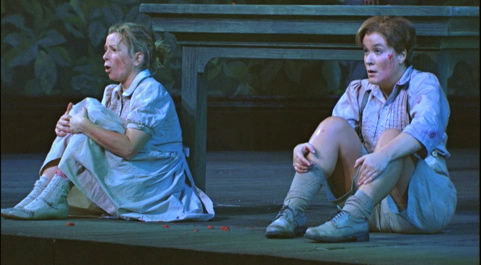
To be fair, Jones does not monkey around with the beautiful children’s prayer near the end of Scene 2. Christine Sché¤fer as Gretel and Alice Coote as Hansel both have lovely voices and they blend in perfect harmony. Throughout the song they are virtually motionless with pleasant faces, all as befits the solemnity appropriate to the recital of an Evening Prayer.
But then we have the Dream sequence! The music, of course, segues smoothly from the last notes of the prayer to the first notes of the ballet, but . . . . Would you like to try an experiment? Go here and listen to selection 1-16 while watching the picture above. Immediately click on 1-17 and scroll down to the picture at the very end of this review. Which of the two pictures there is more appropriate to the music of the dream sequence? Bah! Humbug!
I don’t blame the performers. They did the best they could with the excellent singing that I take for granted with the Met. Both the Father (Alan Held) and the Mother (Rosalind Plowright) looked their parts, although I thought the Mother overacted a bit in Act I. [Trivia note: in the program the parents are named Peter and Gertrud, but those names do not appear in the libretto].
Philip Langridge’s Witch really got into the spirit of Jones production, running and leaping about the kitchen like a demented Julia Child in double-time. At one point he was dumping ingredients into a giant mixer faster than the eye could follow, then madly stirring the gelatinous mess in a giant pot and pouring the result into Hansel’s mouth through a large funnel. A bit gross for my taste, but Humperdinck’s witch’s music admits of more license than his other airs, so the scene was relatively concordant.
Even where there no actual disharmony, there is distracting irrelevance. The Sandman (Sasha Cooke) has a rather sinister appearance, but judging by his well-sung words,
he is a most benign character. Granted that in real life an evil-looking face may house the soul of a saint, opera is not real life – it is illusion. So why not reinforce the illusion rather than raise doubts about it?
Likewise, Lisette Oropesa looked like the maid in a Noel Coward drawing room comedy although she did a nice job singing the part of the Dew Fairy.
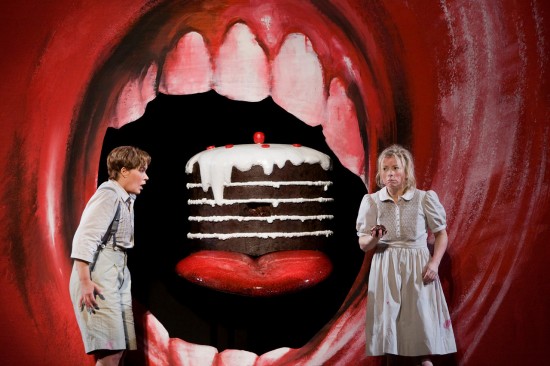
In Act III, things get even worse. Now there is discord between the libretto and the action – what the actors say is different from what they do, and the printed synopsis (also available on the Met web site) supports their words rather than their actions. For example, the synopsis says:
but they don’t see any kind of a house. They see a 5-foot tall gaping mouth with an enormous cake resting on an obscene protruding mechanical tongue. Hansel sings, “Ooh, I’m for a piece of the eave, and you, Gretel, try some of this window pane,” but they are actually breaking off pieces of the pictured cake.
But the oven doesn’t explode. We see the witch writhing in agony for a while, and later her corpse is taken out, transmogrified into a delicious gingerbread treat,

and laid out on the banquet table for the reunited family and all the children to enjoy. (And, as always, the Met’s Children’s Choir is a joy to see and listen to).
Pleasant dreams,
See what I mean? If you don’t agree that the 1982 picture is a far better interpretation of Humperdinck’s music, then you and I are on totally different wave lengths – you might even enjoy the new production!
Scroll back up to the picture of the two children if you want to read the rest of my review. – – O.N.
This review by Philip G Hodge appeared in sanfranciscosplash.com on January 1, 2012.





